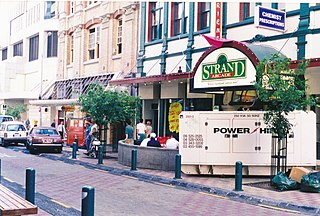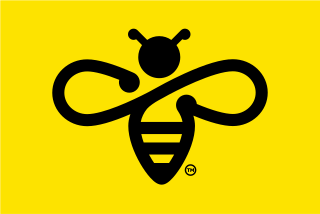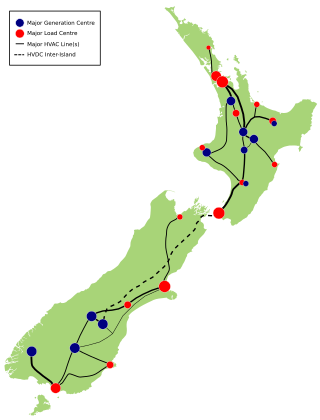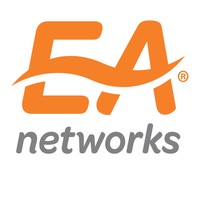The New Zealand electricity market (NZEM) is a decentralised electricity market regulated by the Electricity Industry Participation Code administered by the Electricity Authority (EA). The authority was established in November 2010 to replace the Electricity Commission.

The electric power industry covers the generation, transmission, distribution and sale of electric power to the general public and industry. The commercial distribution of electric power started in 1882 when electricity was produced for electric lighting. In the 1880s and 1890s, growing economic and safety concerns lead to the regulation of the industry. What was once an expensive novelty limited to the most densely populated areas, reliable and economical electric power has become an essential aspect for normal operation of all elements of developed economies.
Transpower New Zealand Limited (TPNZ) is the state-owned enterprise responsible for electric power transmission in New Zealand. It performs two major functions in the New Zealand electricity market. As the owner of the National Grid it provides the infrastructure of electric power transmission that allows consumers to have access to generation from a wide range of sources, and enables competition in the wholesale electricity market; as system operator it manages the real-time operation of the grid and the physical operation of the electricity market.

The 1998 Auckland power crisis was a five-week-long power outage affecting the central city of Auckland, New Zealand from 19 February to 27 March 1998. A 1998 ministerial inquiry criticised both the Auckland Electric Power Board and its privatised successor, which had halved its staff after taking over in October 1993. The report blamed risk and asset management and contingency planning, but said reviews of the electricity network were in accordance with industry practice. However, Mercury Energy’s Board had known for 5 years of a potential failure of the power cables, but, instead of also replacing them, took the cost-saving risk of only building a replacement tunnel, which wasn't ready in time. The inquiry report also said, "Internal expertise in 110 kV assets was not maintained at a sufficient level".
Entrust, formerly named Auckland Energy Consumer Trust (AECT) prior to June 2016, is a trust for electricity consumers in Auckland, New Zealand. Formed in 1993 as sole owner of the original Mercury Energy Limited, it is now majority owner of electricity and gas distributor Vector Limited, a child of the original Mercury, the other child being the retailing division of Mercury Energy. The Trust will be wound up in 2073 and its assets transferred to the local government authority or authorities in the Trust district. There have been calls for the Trust to be wound up sooner.

Manawa Energy limited is a New Zealand electricity generation company that offers bespoke electricity products to commercial and industrial customers across New Zealand. Manawa energy currently operate 26 power schemes from the Bay of Plenty in the north, to Otago in the south.

Mercury NZ Limited is a New Zealand electricity generation and multi-product utility retailer of electricity, gas, broadband and mobile telephone services. All the company's electricity generation is renewable. Mercury has a pre-paid electricity product sub-brand GLOBUG. Mercury Energy is also the largest electricity retailer in New Zealand.
Powerco is the largest dual-energy distribution company in New Zealand by length, and is one of only two dual-energy distributors in the country.
The electricity sector in New Zealand uses mainly renewable energy, such as hydropower, geothermal power and increasingly wind energy. As of 2019, 82% of electricity is generated from renewable sources, making New Zealand one of the countries with the lowest carbon dioxide emissions from electricity generation. Electricity demand grew by an average of 2.1% per year from 1974 to 2010 but decreased by 1.2% from 2010 to 2013.

The National Grid is the nationwide system of electric power transmission in New Zealand. The grid is owned, operated and maintained by Transpower New Zealand, a state-owned enterprise, although some lines are owned by local distribution companies and leased to Transpower. In total, the national grid contains 11,803 kilometres (7,334 mi) of high-voltage lines and 178 substations.

Orion New Zealand Limited (Orion) is an electricity distribution company, based in Christchurch, New Zealand.

WEL Networks Limited is an electricity distribution company, serving the northern and central Waikato region of New Zealand. WEL is the sixth largest electricity distribution company in New Zealand, with 100,142 connections and 7,021 km (4,363 mi) of lines and underground cables. The company is 100% owned by the WEL Energy Trust.
The North Auckland and Northland (NAaN) grid upgrade project reinforced transmission into the Auckland Region and across the harbour to North Auckland and the Northland Region. It added new 220 kV transmission capacity to the National Grid by providing 37 km of underground cable between the Pakuranga, Penrose, and Albany substations.

Marlborough Lines Limited is an electricity distribution company, based in Blenheim, New Zealand. Marlborough Lines is responsible for subtransmission and distribution of electricity to approximately 26,000 customers in the Marlborough Region over a service area of 11,330 km2 (4,370 sq mi). The network includes approximately 3,400 km (2,100 mi) of power lines extending to some very isolated areas across the region, including the extremities of the Marlborough Sounds, which can only be reached by boat or helicopter.
Wellington Electricity, registered as Wellington Electricity Lines Limited, is an electricity distribution company, based in Wellington, New Zealand.

Electricity Ashburton Limited, trading as EA Networks is a co-operatively-owned electricity distribution company, based in Ashburton, New Zealand.
Northpower Limited (Northpower) is an electricity distribution company, based in Whangarei, New Zealand.

Unison Networks Limited (Unison) is an electricity distribution based in Hastings, New Zealand.
First Gas Limited is a natural gas transmission and distribution company in New Zealand. First Gas's network has 2,204 km of high pressure pipelines and 4,800 km of gas distribution pipelines. Through Flex Gas, First Gas owns and operates the Ahuroa Gas Storage Facility.
Top Energy Limited is an electricity distribution and generation company based in Kerikeri, New Zealand. It owns and manages the electricity lines network in the Far North District of New Zealand, including Kaitaia, Kerikeri and Kaikohe. The service area covers 6,822 km2 and serves over 32,000 customers. It also owns and operates the Ngāwhā Geothermal Power Station.











